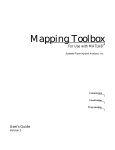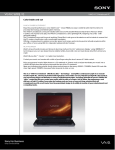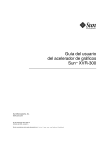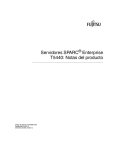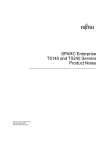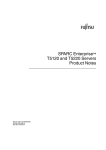Download Sun SPARC Enterprise T5120 and T5220 Servers Product Notes
Transcript
Sun SPARC Enterprise T5120 and T5220 Servers
Product Notes
Part No.: E21877-04
December 2011
Copyright © 2008, 2011, Oracle and/or its affiliates. All rights reserved.
FUJITSU LIMITED provided technical input and review on portions of this material.
This software and related documentation are provided under a license agreement containing restrictions on use and disclosure and are protected by
intellectual property laws. Except as expressly permitted in your license agreement or allowed by law, you may not use, copy, reproduce, translate,
broadcast, modify, license, transmit, distribute, exhibit, perform, publish, or display any part, in any form, or by any means. Reverse engineering,
disassembly, or decompilation of this software, unless required by law for interoperability, is prohibited.
The information contained herein is subject to change without notice and is not warranted to be error-free. If you find any errors, please report them to us
in writing.
If this is software or related software documentation that is delivered to the U.S. Government or anyone licensing it on behalf of the U.S. Government, the
following notice is applicable:
U.S. GOVERNMENT RIGHTS. Programs, software, databases, and related documentation and technical data delivered to U.S. Government customers
are "commercial computer software" or "commercial technical data" pursuant to the applicable Federal Acquisition Regulation and agency-specific
supplemental regulations. As such, the use, duplication, disclosure, modification, and adaptation shall be subject to the restrictions and license terms set
forth in the applicable Government contract, and, to the extent applicable by the terms of the Government contract, the additional rights set forth in FAR
52.227-19, Commercial Computer Software License (December 2007). Oracle America, Inc., 500 Oracle Parkway, Redwood City, CA 94065.
This software or hardware is developed for general use in a variety of information management applications. It is not developed or intended for use in any
inherently dangerous applications, including applications which may create a risk of personal injury. If you use this software or hardware in dangerous
applications, then you shall be responsible to take all appropriate fail-safe, backup, redundancy, and other measures to ensure its safe use. Oracle
Corporation and its affiliates disclaim any liability for any damages caused by use of this software or hardware in dangerous applications.
Oracle and Java are registered trademarks of Oracle and/or its affiliates. Other names may be trademarks of their respective owners.
AMD, Opteron, the AMD logo, and the AMD Opteron logo are trademarks or registered trademarks of Advanced Micro Devices. Intel and Intel Xeon are
trademarks or registered trademarks of Intel Corporation. All SPARC trademarks are used under license and are trademarks or registered trademarks of
SPARC International, Inc. UNIX is a registered trademark licensed through X/Open Company, Ltd.
This software or hardware and documentation may provide access to or information on content, products, and services from third parties. Oracle
Corporation and its affiliates are not responsible for and expressly disclaim all warranties of any kind with respect to third-party content, products, and
services. Oracle Corporation and its affiliates will not be responsible for any loss, costs, or damages incurred due to your access to or use of third-party
content, products, or services.
Copyright © 2008, 2011, Oracle et/ou ses affiliés. Tous droits réservés.
Entrée et revue tecnical fournies par FUJITSU LIMITED sur des parties de ce matériel.
Ce logiciel et la documentation qui l’accompagne sont protégés par les lois sur la propriété intellectuelle. Ils sont concédés sous licence et soumis à des
restrictions d’utilisation et de divulgation. Sauf disposition de votre contrat de licence ou de la loi, vous ne pouvez pas copier, reproduire, traduire,
diffuser, modifier, breveter, transmettre, distribuer, exposer, exécuter, publier ou afficher le logiciel, même partiellement, sous quelque forme et par
quelque procédé que ce soit. Par ailleurs, il est interdit de procéder à toute ingénierie inverse du logiciel, de le désassembler ou de le décompiler, excepté à
des fins d’interopérabilité avec des logiciels tiers ou tel que prescrit par la loi.
Les informations fournies dans ce document sont susceptibles de modification sans préavis. Par ailleurs, Oracle Corporation ne garantit pas qu’elles
soient exemptes d’erreurs et vous invite, le cas échéant, à lui en faire part par écrit.
Si ce logiciel, ou la documentation qui l’accompagne, est concédé sous licence au Gouvernement des Etats-Unis, ou à toute entité qui délivre la licence de
ce logiciel ou l’utilise pour le compte du Gouvernement des Etats-Unis, la notice suivante s’applique :
U.S. GOVERNMENT RIGHTS. Programs, software, databases, and related documentation and technical data delivered to U.S. Government customers
are "commercial computer software" or "commercial technical data" pursuant to the applicable Federal Acquisition Regulation and agency-specific
supplemental regulations. As such, the use, duplication, disclosure, modification, and adaptation shall be subject to the restrictions and license terms set
forth in the applicable Government contract, and, to the extent applicable by the terms of the Government contract, the additional rights set forth in FAR
52.227-19, Commercial Computer Software License (December 2007). Oracle America, Inc., 500 Oracle Parkway, Redwood City, CA 94065.
Ce logiciel ou matériel a été développé pour un usage général dans le cadre d’applications de gestion des informations. Ce logiciel ou matériel n’est pas
conçu ni n’est destiné à être utilisé dans des applications à risque, notamment dans des applications pouvant causer des dommages corporels. Si vous
utilisez ce logiciel ou matériel dans le cadre d’applications dangereuses, il est de votre responsabilité de prendre toutes les mesures de secours, de
sauvegarde, de redondance et autres mesures nécessaires à son utilisation dans des conditions optimales de sécurité. Oracle Corporation et ses affiliés
déclinent toute responsabilité quant aux dommages causés par l’utilisation de ce logiciel ou matériel pour ce type d’applications.
Oracle et Java sont des marques déposées d’Oracle Corporation et/ou de ses affiliés.Tout autre nom mentionné peut correspondre à des marques
appartenant à d’autres propriétaires qu’Oracle.
AMD, Opteron, le logo AMD et le logo AMD Opteron sont des marques ou des marques déposées d’Advanced Micro Devices. Intel et Intel Xeon sont des
marques ou des marques déposées d’Intel Corporation. Toutes les marques SPARC sont utilisées sous licence et sont des marques ou des marques
déposées de SPARC International, Inc. UNIX est une marque déposée concédée sous licence par X/Open Company, Ltd.
Ce logiciel ou matériel et la documentation qui l’accompagne peuvent fournir des informations ou des liens donnant accès à des contenus, des produits et
des services émanant de tiers. Oracle Corporation et ses affiliés déclinent toute responsabilité ou garantie expresse quant aux contenus, produits ou
services émanant de tiers. En aucun cas, Oracle Corporation et ses affiliés ne sauraient être tenus pour responsables des pertes subies, des coûts
occasionnés ou des dommages causés par l’accès à des contenus, produits ou services tiers, ou à leur utilisation.
Please
Recycle
Sun SPARC Enterprise T5120 and
T5220 Product Notes
These product notes contain important and late-breaking information about Oracle’s
Sun SPARC Enterprise T5120 and T5220 servers.
This information is organized into the following sections:
■
“General Information” on page 2
■
“Documentation, Support, and Training” on page 2
■
“Supported Versions of Oracle Solaris and Sun System Firmware” on page 3
■
“Oracle Solaris OS and Firmware Requirements for Certain Features” on page 4
■
“Preinstalled Software” on page 5
■
“Patch Information” on page 5
■
“Rules for PCIe Slot Use by Certain HBA Cards” on page 7
■
“Known Product Issues” on page 8
■
“Product Documentation Errata” on page 24
1
General Information
This section contains information of a general interest.
Major New Features
The following new feature has been added to the Sun SPARC Enterprise T5120 and
T5220 servers in this release:
■
Firmware support for the following new features:
■
Support for lifespan monitoring of the Sun Flash Accelerator F20 PCIe Card’s
Energy Storage Module (ESM).
See the Sun Flash Accelerator F20 PCIe Card documentation for specific
instructions and service requirements for this card.
■
Support for the LDoms 1.3 software.
Documentation, Support, and Training
These web sites provide additional resources:
■
Documentation
http://www.oracle.com/technetwork/indexes/documentation/
index.html
■
Support https://support.oracle.com
■
Training https://education.oracle.com
Note – Information in these product notes supersedes the information in the SPARC
Enterprise T5120 and T5220 documentation sets.
2
Sun SPARC Enterprise T5120 and T5220 Servers Product Notes • December 2011
Supported Versions of Oracle Solaris and
Sun System Firmware
TABLE 0-1 lists the versions of the Oracle Solaris Operating System (OS) and system
firmware that is supported in this release.
Your server is preinstalled with the latest supported OS, patches and firmware. If
you decide to install some other supported version, be certain to also install the
patches required by that version. For information on OS patch requirements, see
“Patch Information” on page 5.
Note – If you install an OS over the preinstalled OS (even if it is the same version)
you will overwrite the supplementary software that was preinstalled at the factory.
See “Preinstalled Software” on page 5 for more information on this additional
preinstalled software.
TABLE 0-1
Supported Versions of the Operating System and Firmware
Component
Supported Versions
OS
Oracle Solaris 10 8/07 OS (U4) plus mandatory patches – Minimum
supported OS
Oracle Solaris 10 5/08 OS (U5) plus patches
Oracle Solaris 10 10/08 OS (U6)
Oracle Solaris 10 5/09 OS (U7)
Oracle Solaris 10 10/09 OS (U8) – preinstalled
Oracle Solaris 10 9/10 OS (U9)
Firmware
System Firmware 7.0.3.b – Minimum supported System Firmware
System Firmware 7.1.6.d
System Firmware 7.1.6.j
System Firmware 7.2.0
System Firmware 7.2.2.d
System Firmware 7.2.2.e
System Firmware 7.2.4.e
System Firmware 7.2.7.d
System Firmware 7.2.9.a
Sun SPARC Enterprise T5120 and T5220 Product Notes
3
TABLE 0-1
Supported Versions of the Operating System and Firmware (Continued)
Component
Supported Versions
System Firmware 7.2.10.a
System Firmware 7.3.0
System Firmware 7.3.1.a or later (preinstalled)
Oracle Solaris OS and Firmware
Requirements for Certain Features
The following table identifies the minimum OS and firmware versions required to
support certain features.
TABLE 0-2
Minimum Firmware Version Requirements for Certain Features
Feature
Minimum Firmware Version
Minimum OS Version
Systems operating with DC power
supplies
7.1.6.d
Oracle Solaris 10 10/08
OS
Systems using the Sun External I/O
Expansion Unit
7.1.6.d
Oracle Solaris 10 10/08
OS
Oracle ILOM 3.0 firmware
7.2.0
N/A
1.6 GHz processors
7.2.2.e
N/A
LDOMs 1.2
7.2.2.e
Oracle Solaris 10 5/09
OS*
Sun Flash Accelerator F20 PCIe Card
7.2.4.e
N/A
LDoms 1.3
7.2.7.d
Oracle Solaris 10 10/09
OS†
Oracle VM for SPARC 2.0
7.3.0.c or later
Oracle Solaris 10 5/10
OS
* For informaiton about patch requirements for LDoms 1.2 compatibility with earlier OS versions, see the Logical
Domains 1.2 Release Notes.
† For informaiton about patch requirements for LDoms 1.3 compatibility with earlier OS versions, see the Logical
Domains 1.3 Release Notes.
Note – To benefit from the accumulated features, enhancements, and fixes, upgrade
your system firmware to the most recent version available.
4
Sun SPARC Enterprise T5120 and T5220 Servers Product Notes • December 2011
Preinstalled Software
The following table lists the software preinstalled on your server.
TABLE 0-3
Preinstalled Software for Standard Configurations
Software
Location
Function
Oracle Solaris 10 10/09
The root (/) partition is installed on Operating system
Slice 0. The core OS is on Slice 3,
serving as a Live Upgrade alternate
boot environment (ABE).
CMT Tools 1.2
/opt/SUNWspro/extra/bin
Cool Tools GCC 4.3.2
/opt/gcc and /opt/SUNW0scgfss GCC compiler for SPARC systems
LDoms Manager 1.3
LDoms Manager:
• /opt/SUNWldm
LDoms MIB:
• /opt/SUNWldmib
Manages Logical Domains
Oracle Studio 12 U1
Developer Tools
/opt/sunstudio12
C, C++, and Fortran compiler
Sun Studio Developer Tools
Note – The Oracle Solaris OS is preinstalled both in root disk Slice 0 for normal
operations, and in Slice 3 along with Live Upgrade software to provide an Alternate
Boot Environment (ABE). The ABE enables you to upgrade the OS or perform
system maintenance tasks without reducing performance. An identical (bootable)
copy of the root partition (including the OS, EIS, and applications) is installed as an
ABE in Slice 3.
Patch Information
This section provides information about patch requirements.
Note – You should install the latest Oracle Solaris OS kernel update (KU) patch to
be certain your system has the most current fixes.
Sun SPARC Enterprise T5120 and T5220 Product Notes
5
Patches Required for the Oracle Solaris 10 9/10
OS
At the time this document is published, no patches are required for this distribution.
Patches Required for the Oracle Solaris 10 5/09
OS
At the time this document is published, no patches are required for this distribution.
Patches Required for the Oracle Solaris 10 10/08
OS
At the time this document is published, no patches are required for this distribution.
Patches Required for the Oracle Solaris 10 8/07
OS
The following table identifies the patches known to be required for the Oracle Solaris
10 8/07 OS at the time this document is published.
TABLE 0-4
Mandatory Patch for Servers Installed with the Oracle Solaris 10 8/07 OS
Patch IDs
Description
Fixes Provided
127127-11 or later
SunOS 5.10: kernel
patch
Includes the following fixes:
• CR 6590132: System panics (n2cp alignment
error) in IPsec testing
• Issues regarding data integrity in the nxge
driver as reported by Sun Alert ID 103076
• CR 6568352: IPsec performance does not scale
using hardware crypto providers
Patches for Option Cards
If you add option cards to your server, refer to the documentation and README
files for each card to determine if additional patches are needed.
6
Sun SPARC Enterprise T5120 and T5220 Servers Product Notes • December 2011
Rules for PCIe Slot Use by Certain HBA
Cards
Some optional I/O cards are restricted to particular PCIe slots to enable more
effective cooling for themselves and other components in the chassis. The following
chart identifies the cards that have this restriction.
TABLE 0-5
PCIe Slot Usage Rules for Certain HBA Cards
System
HBA Card
T5120
Sun Flash Accelerator F20 PCIe Card
PCIe Slots
Allowed
0, 2
Sun StorageTek x8 SAS RAID HBA
2
Sun 10-gigabit Ethernet XFP SR PCIe card and
Sun Dual 10-gigabit Ethernet XFP 2 SR PCIe card
Sun StorageTek SAS RAID External HBA
Sun Storage 6GbSAS PCI RAID HBA
T5220
Any
2
0
Sun Flash Accelerator F20 PCIe Card
Sun Flash Accelerator F20 PCIe Card
0, 2, 3, 4, 5
0, 2, 5
Notes
Limit, 2 cards
Internal connectors cannot be used
Limit, 1 card
Limit, 2 single- and/or dual-port
cards in any combination
Preferred for performance
Secondary choice
Limit, 1 card
Limit, 5 cards in 8-disk systems
Limit, 3 cards in 16-disk systems
Internal connectors cannot be used
Sun StorageTek x8 SAS RAID HBA
2, 5
Limit, 1 card
Sun 10-gigabit Ethernet XFP SR PCIe card and
Sun Dual 10-gigabit Ethernet XFP 2 SR PCIe card
Any
Limit, 4 single- and/or dual-port
cards in any combination
Sun StorageTek SAS RAID External HBA
Sun Storage 6GbSAS PCI RAID HBA
2, 5
0, 3*
Preferred for performance
Secondary choice
Limit, 1 card per system
* This card is not allowed in slot 3 in systems shipped with part number 501-7760-0x backplanes.
Sun SPARC Enterprise T5120 and T5220 Product Notes
7
Known Product Issues
This section describes issues that are known to affect the T5120 and T5220 servers.
The issue descriptions are organized as follows:
■
“Hardware and Mechanical Issues” on page 8
■
“Ethernet Interface Related Issues” on page 12
■
“Oracle Solaris OS Issues” on page 13
■
“Firmware, Oracle ILOM, POST, and SP Issues” on page 20
Hardware and Mechanical Issues
This section describes hardware issues known to exist at this release of the SPARC
Enterprise T5120 and T5220 servers.
TABLE 0-6
Hardware-Related Issues on the Sun SPARC Enterprise T5120 and T5220 Servers
CR ID
Description
Workaround
6480945
If a hard drive fails in RAID 0 or RAID 1
configurations, error messages might not be
displayed on the console or in the log files.
If you encounter failed disks in RAID 0 or RAID
1 configurations, and you see the following
scenario, the disk drive should be replaced:
• The Fault LED is lit on a disk drive that is part
of a RAID 0 or RAID 1 volume.
• The error condition can be displayed remotely
by running the showenvironment command
on the service processor.
• The hard drive that has the Fault LED
illuminated displays a status of Failed and the
service indicator is set to on.
Replace the disk drive with the lit Fault LED.
6823163
In servers with 8- and 16-disk backplanes, the
32GB SATA SSD drive may not install in some
drive bay slots.
1.
2.
3.
4.
6840287
When a server is power cycled with DVD media Ignore the message.
installed, the message "Device is gone" will be
displayed approximately 30 minutes after the OS
is booted up.
8
Loosen all the screws on the backplane.
Install SSDs in the corner drive bays.
Tighten all backplane screws.
Install remaining SSDs (if any).
Sun SPARC Enterprise T5120 and T5220 Servers Product Notes • December 2011
TABLE 0-6
Hardware-Related Issues on the Sun SPARC Enterprise T5120 and T5220 Servers (Continued)
CR ID
Description
Workaround
6857080
Systems with firmware version 7.2.2.x have low Ensure that the air flowing into the server is
fan speed (5000 rpms). The low fan speed
within the ambient temperature specification.
condition can result in SC Alerts that warn of the
low fan speed.
N/A
When the system is initialized, firmware is
loaded and occupies approximately 128 MB to
352 MB of the host memory. The banner and
other software utilities report an amount of
memory minus the amount of memory that is
occupied by firmware.
When viewing the amount of memory in the
banner, be aware that the banner reports the
amount less what is used by the firmware.
N/A
The On/Standby portion of the service label
contains an error. It says to press and hold the
On/Standby button for “5 seconds”. It should
say “4 seconds”.
Note - This error appears on the service labels
on all Sun SPARC Enterprise T5120 and T5220
server configurations.
N/A
Some service labels show an extra fan module in Note - This error appears on the service label for
Sun SPARC Enterprise T5120 servers with 4-disk
step 2 of the four-step fan board diagram. The
capable backplanes.
extra fan is on the right half of FanBD0.
N/A
On service labels that show the locations of PCIe Note - This error appears on the service labels
for Sun SPARC Enterprise and T5220 servers.
and XAUI slots, the XAUI callouts are wrong.
They should point to the lower slots.
N/A
The FM Status Indicator portion of the service
Note - This error appears on the service labels
label has an erroneous statement. Where it says, for Sun SPARC Enterprise T5220 servers.
“In front of FM on FanBD” it should say, “on top
of FM”.
N/A
The drawing showing the cable management
arm being rotated represents the wrong server
model. It should show the Sun SPARC
Enterprise T5220 server,
Note - This error appears on the service labels
for Sun SPARC Enterprise T5220 servers.
N/A
The Fan Module Configuration portion of the
service label is wrong. It should show a fan
module in location FANBD1, FM1.
Note - This error appears on the service labels
for Sun SPARC Enterprise T5220 servers with 16disk capable backplanes.
Sun SPARC Enterprise T5120 and T5220 Product Notes
9
False Intermittent SATA Errors (CR 6880299)
When booting the Oracle Solaris 10 5/08 OS (S10 U5), some systems with SATA
DVD devices intermittently log port failur errors in /var/adm/messages. The
following shows an example of typical error messages:
/pci@400/pci@0/pci@1/pci@0/usb@0,1 (ohci1): Connecting device on port 1 failed
/pci@400/pci@0/pci@1/pci@0/usb@0,2 (ehci0): Connecting device on port 2 failed
Workaround: You can ignore these messages.
Misalignment of Backplane to HDD Cage in Some 8- and
16-Disk Systems
It has been found in some 8-disk and 16-disk systems that SSDs and/or disk drives
cannot be fully inserted the hard drive bays. This problem can result from
misalignment between the backplane and hard drive cage.
If you have a system that exhibits this problem, you may be able to correct the
backplane misalignment using a retention bracket. This is available as an orderable
FRU (field replaceable unit), part number 542-0355.
Instructions for using the retention bracket are included with the part.
Note – In some cases, the retention bracket can be installed without removing the
HDD cage. In cases where the HDD cage must be removed, the procedure must be
performed by qualified service personnel.
Hard Drives Can Be Difficult to Remove From Right-Side
Drive Bays
Hard drives in the right-side drive bays can be difficult to remove.
Workaround: Until a mechanical fix is implemented, use the following procedure to
remove hard drives from right-side drive bays.
1. Press the drive to the right.
See Step 1 in the following figure.
2. Push in on the drive, while holding it pressed to the right.
See Step 2 in the following figure.
10
Sun SPARC Enterprise T5120 and T5220 Servers Product Notes • December 2011
3. Press the drive eject button and pull on the eject lever.
See Step 3 in the following figure.
4. Use the eject lever to slide the drive out of the bay.
See Step 4 in the following figure.
Note on Bus Bar Assembly Between Power Distribution
Board and Motherboard
The motherboard is connected to the power distribution board with a ribbon cable
and a bus bar assembly. When installing a motherboard, you must ensure that the
bus bar screws are tightened securely.
In addition, when installing a replacement power distribution board (PDB), you
must transfer the bus bar assembly from the old PDB to the new PDB.
Note – The PDB on the SPARC Enterprise T5220 has additional bus bar connections
to the power supply backplane.
Sun SPARC Enterprise T5120 and T5220 Product Notes
11
When reassembling the system, ensure that all bus bar screws are tightened securely.
Caution – Loose bus bar screws can cause arcing between the bus bar assembly and
other internal components, potentially damaging the server and posing a fire
hazard.
Fordetailed motherboard and power distribution board installation procedures, see
the SPARC Enterprise T5120 and T5220 Servers Service Manual.
Ethernet Interface Related Issues
There are no issues related to the Ethernet interface in this release.
12
Sun SPARC Enterprise T5120 and T5220 Servers Product Notes • December 2011
Oracle Solaris OS Issues
This section describes issues related to the Oracle Solaris OS known to affect this
release of the Sun SPARC Enterprise T5120 and T5220 servers.
TABLE 0-7
Oracle Solaris OS Issues
CR
Description
Workaround
6373437
(6588499)
A Oracle Solaris OS shutdown might hang and
result in fewer system services.
Rarely, a shutdown performed immediately after
the Oracle Solaris OS boots might cause the
system to hang because some system services
are attempting to stop while others are still in
the process of starting. The hang occurs with a
message similar to the following:
svc.startd: The system is coming down.
Please wait
svc.startd: 74 system services are now
being stopped
Reboot the system by dropping to the service
processor (SP). Then power cycle the host
system using one of the following methods:
• From the Oracle ILOM CLI:
-> stop /SYS
-> start /SYS
• From the ALOM CMT compatibility CLI:
sc> poweroff
sc> poweron
sc> powercycle
6607315
Use the virtual console as the input device.
The login prompt resets five seconds after the
Oracle Solaris OS boots.
This only occurs when using a local keyboard as
the input device (input-device=keyboard).
This issue does not occur with the virtualconsole.
N/A
The output of the raidctl -h command and
the raidctl man page display some
unsupported features.
The Sun SPARC Enterprise T5120 and T5220
servers currently only support RAID 0 and
RAID 1 for the on board SAS disk controller. The
raidctl utility can be used to create and delete
RAID 0 & RAID 1 volumes. Refer to the Sun
SPARC Enterprise T5120 and T5220 Servers
Administration Guide for supported RAID
information.
Boot Drive May Report “drive type unknown” for Oracle
Solaris format Command (CR 6886514)
During a period extending from mid-September to early October 2009
(approximately 3 weeks) a patch was preinstalled on some Sun SPARC Enterprise
T5120 and T5220 servers which introduced a latent bug into those systems. The bug
is described as “latent” because it is activated only when the Oracle Solaris format
command is used. Otherwise, the bug has no effect on system behavior or
performance.
Sun SPARC Enterprise T5120 and T5220 Product Notes
13
When a system administrator or other user with root (/) privileges enters the format
command on a system containing this bug, the boot drive will report “drive type
unknown”. This fault condition presents two problems for the administrator:
■
The administrator will be unable to access unused portions of the boot drive
because of the unknown drive type error.
■
The presence of mounted partitions blocks use of the format utility’s auto
configure feature. Attempts to bypass this restriction by booting from the network
or removable media could put the system in an unbootable state.
The Workaround section below describes a procedure you can use
Workaround: Use the procedure described below to recover from this “drive type
unknown” fault mode without the risks associated with the network and media boot
methods.
Note – The following sequence of steps must be followed exactly as shown.
1. Determine if the boot drive is affected.
root@host-1 # uname -a
SunOS host-1 5.10 Generic_141414-10 sun4v sparc SUNW,SPARC-Enterprise-T5220
root@host-1 # mount -p | head -1
/dev/dsk/c0t0d0s0 - / ufs - no rw,intr,largefiles,logging,xattr,onerror=panic
root@host-1 # format c0t0d0s0 <========== boot device determined previously
/dev/dsk/c0t0d0s0 is currently mounted on /. Please see umount(1M).
/dev/dsk/c0t0d0s1 is currently used by swap. Please see swap(1M).
FORMAT MENU:
disk
type
partition
current
format
repair
label
analyze
defect
backup
verify
save
inquiry
volname
!<cmd>
quit
format> disk
-
select a disk
select (define) a disk type
select (define) a partition table
describe the current disk
format and analyze the disk
repair a defective sector
write label to the disk
surface analysis
defect list management
search for backup labels
read and display labels
save new disk/partition definitions
show vendor, product and revision
set 8-character volume name The jumpstart install process
execute <cmd>, then return
The jumpstart install process
14
Sun SPARC Enterprise T5120 and T5220 Servers Product Notes • December 2011
AVAILABLE DISK SELECTIONS:
0. c0t0d0 <drive type unknown>
/pci@0/pci@0/pci@2/scsi@0/sd@0,0
Specify disk (enter its number)[0]: ^C
format> quit
root@host-1 #
<========== problem indication
<========== quit with <ctrl>C
2. Shut the server down; then bring it up in single user mode with root file system
mounted read only.
root@host-1 # init 0
Oct 20 16:26:56 host-1 syslogd: going down on signal 15
svc.startd: The system is down.
syncing file systems... done
Program terminated
SPARC Enterprise T5220, No Keyboard
Copyright 2009 Sun Microsystems, Inc. All rights reserved.
OpenBoot 4.30.4, 3968 MB memory available, Serial #xxxxxxxx.
Ethernet address xx:xx:xx:xx:xx:xx, Host ID: xxxxxxxx.
{0} ok boot -m milestone=none
Boot device: /pci@0/pci@0/pci@2/scsi@0/disk@0,0:a File and args: -m
milestone=none
SunOS Release 5.10 Version Generic_141414-10 64-bit
Copyright 1983-2009 Sun Microsystems, Inc. All rights reserved.
Use is subject to license terms.
Booting to milestone "none".
Requesting System Maintenance Mode
(See /lib/svc/share/README for more information.)
Console login service(s) cannot run
Root password for system maintenance (control-d to bypass): <====== login
single user mode
single-user privilege assigned to /dev/console.
Entering System Maintenance Mode
Oct 20 18:06:11 su: ’su root’ succeeded for root on /dev/console
Sun Microsystems Inc.SunOS 5.10GenericJanuary 2005
Sourcing //.profile-EIS.....
Sun SPARC Enterprise T5120 and T5220 Product Notes
15
3. Mount the tmpfs /tmp file system to provide a working area.
root@ # mount -F tmpfs /tmp
root@ # cd /tmp
4. Capture the boot drive’s existing vtoc ins a file stored in /tmp. Use the raw
device of the boot device determined at the beginning. That is, use
/dev/rdsk/c?t?d?, not /dev/dsk/c?t?d?s?.
root@ # prtvtoc /dev/rdsk/c0t0d0s0 > /tmp/vtoc <======boot disk vtoc saved
/dev/dsk/c?t?d?s?
5. Make a copy of the fmthard utility for use in the /tmp work area..
root@ #
cp /usr/sbin/fmthard /tmp
6. Set and export the NOINUSE_CHECK variable.
root@ # NOINUSE_CHECK=1
root@ # export NOINUSE_CHECK
7. Run the format utility to restore the drive’s “type”.
root@ # format
Searching for disks...done
AVAILABLE DISK SELECTIONS:
0. c0t0d0 <drive type unknown> <========== drive type unknown is the issue
/pci@0/pci@0/pci@2/scsi@0/sd@0,0
Specify disk (enter its number): 0
Format will now present the following menu, choose 0. Auto configure
AVAILABLE DRIVE TYPES:
0. Auto configure
1. Quantum ProDrive 80S
2. Quantum ProDrive 105S
[...]
17. Zip 250
18. Peerless 10GB
19. other
Specify disk type (enter its number): 0
c0t0d0: configured with capacity of 68.35GB
<SUN72G cyl 14087 alt 2 hd 24 sec 424>
selecting c0t0d0
[disk formatted]
16
<======= drive type corrected
<======= drive type corrected
Sun SPARC Enterprise T5120 and T5220 Servers Product Notes • December 2011
Following Auto configure, the correct drive value should be reported.
FORMAT MENU:
disk
- select a disk
type
- select (define) a disk type
partition - select (define) a partition table
current
- describe the current disk
format
- format and analyze the disk
repair
- repair a defective sector
label
- write label to the disk
analyze
- surface analysis
defect
- defect list management
backup
- search for backup labels
verify
- read and display labels
save
- save new disk/partition definitions
inquiry
- show vendor, product and revision
volname
- set 8-character volume name The jumpstart install process
!<cmd>
- execute <cmd>, then return
quit
format> label
Ready to label disk, continue? y
format> quit
root@ #
8. Use the fmthard command and stored information to complete the recovery.
root@ # /tmp/fmthard -s /tmp/vtoc /dev/rdsk/c0t0d0s0
used to capture vtoc.
fmthard: New volume table of contents now in place.
root@ #
<=== raw boot device
9. Verify the success of the recovery.
root@ # format
Searching for disks...done
AVAILABLE DISK SELECTIONS:
0. c0t0d0 <SUN72G cyl 14087 alt 2 hd 24 sec 424>
/pci@0/pci@0/pci@2/scsi@0/sd@0,0
Specify disk (enter its number): 0
selecting c0t0d0
[disk formatted]
FORMAT MENU:
disk
type
partition
- select a disk
- select (define) a disk type
- select (define) a partition table
Sun SPARC Enterprise T5120 and T5220 Product Notes
17
current
format
repair
label
analyze
defect
backup
verify
save
inquiry
volname
!<cmd>
quit
format> partition
describe the current disk
format and analyze the disk
repair a defective sector
write label to the disk
surface analysis
defect list management
search for backup labels
read and display labels
save new disk/partition definitions
show vendor, product and revision
set 8-character volume name The jumpstart install process
execute <cmd>, then return
PARTITION MENU:
0
- change ‘0’ partition
1
- change ‘1’ partition
2
- change ‘2’ partition
3
- change ‘3’ partition
4
- change ‘4’ partition
5
- change ‘5’ partition
6
- change ‘6’ partition
7
- change ‘7’ partition
select - select a predefined table
modify - modify a predefined partition table
name
- name the current table
print - display the current table
label - write partition map and label to the disk
!<cmd> - execute <cmd>, then return
quit
partition> print
Current partition table (original):
Total disk cylinders available: 14087 + 2 (reserved cylinders)
Part
0
1
2
3
4
5
6
7
Tag
root
swap
backup
unassigned
unassigned
unassigned
unassigned
unassigned
Flag
wm
wu
wm
wm
wu
wu
wu
wu
Cylinders
825 - 3298
0 - 824
0 - 14086
3299 - 5772
0
0
0
0
Size
12.00GB
4.00GB
68.35GB
12.00GB
0
0
0
0
Blocks
(2474/0/0)
25175424
(825/0/0)
8395200
(14087/0/0) 143349312
(2474/0/0)
25175424
(0/0/0)
0
(0/0/0)
0
(0/0/0)
0
(0/0/0)
0
partition> quit
FORMAT MENU:
18
Sun SPARC Enterprise T5120 and T5220 Servers Product Notes • December 2011
disk
type
partition
current
format
repair
label
analyze
defect
backup
verify
save
inquiry
volname
!<cmd>
quit
format> disk
-
select a disk
select (define) a disk type
select (define) a partition table
describe the current disk
format and analyze the disk
repair a defective sector
write label to the disk
surface analysis
defect list management
search for backup labels
read and display labels
save new disk/partition definitions
show vendor, product and revision
set 8-character volume name The jumpstart install process
execute <cmd>, then return
AVAILABLE DISK SELECTIONS:
0. c0t0d0 <SUN72G cyl 14087 alt 2 hd 24 sec 424>
/pci@0/pci@0/pci@2/scsi@0/sd@0,0
Specify disk (enter its number)[0]:
selecting c0t0d0
[disk formatted]
format> quit
The drive type recovery is complete, reboot the server:
root@ # reboot
syncing file systems... done
rebooting...
Resetting...
#
SPARC Enterprise T5220, No Keyboard
Copyright 2009 Sun Microsystems, Inc. All rights reserved.
OpenBoot 4.30.4, 3968 MB memory available, Serial #xxxxxxxx.
Ethernet address xx:xx:xx:xx:xx:xx, Host ID: xxxxxxxx.
Boot device: /pci@0/pci@0/pci@2/scsi@0/disk@0,0:a File and args:
SunOS Release 5.10 Version Generic_141414-10 64-bit
Copyright 1983-2009 Sun Microsystems, Inc. All rights reserved.
Use is subject to license terms.
Hostname: host-1
The / file system (/dev/rdsk/c0t0d0s0) is being checked.
Reading ZFS config: done.
host-1 console login:
Sun SPARC Enterprise T5120 and T5220 Product Notes
19
Firmware, Oracle ILOM, POST, and SP Issues
TABLE 0-8 lists the late-breaking issues for the firmware, Oracle ILOM (including
ALOM compatibility CLI), POST, and service processor (SP). Additional information
for some of the change request (CR) issues is provided following the table.
TABLE 0-8
Firmware, Oracle ILOM, POST, and SP Issues
CR
Description
Workaround
6583567
A communication channel between the primary
domain and the service processor (SP) could hang
and disable communication over the channel.
See “Communication Channel Between the
Primary Domain and the Service Processor
(SP) Might Hang (CR 6583567)” on page 21.
N/A
As of System firmware 7.1.6.d, the following type of
message might be displayed on the console and in the
logs:
Chassis | major: Hot insertion of
/SYS/MB/CMP0/P0
or
SC Alert: [ID 639621 daemon.error] SC
unretrieved msg: [Chassis | major: Hot
insertion of /SYS/MB/CMP0/P3]
Be aware that these messages are not
necessarily error messages.
Messages referring to hot-insertions of
CPUs are displayed at power on if the
system has had a firmware upgrade or
system component change. Once the
components have been identified, no
subsequent messages are displayed unless
Oracle ILOM detects a change in the system
configuration or if a CPU thread or a core
fails.
SSDs Require Firmware Updates To Be Used In Sun
StorageTek SAS RAID Configurations
To use the Sun Storage 32GB SLC SATA Solid State Drives with Sun StorageTek SAS
RAID HBAs, the SSD firmware and HBA firmware must be at the following levels:
■
Minimum SSD firmware level: 8850
■
Minimum RAID HBA firmware level: 16732
Note – The RAID HBA firmware requirement applies to both Sun StorageTek x8
SAS RAID HBAs and Sun StorageTek SAS RAID External HBAs.
To do this, download and install the patch kits that apply to your platform’s
operating system. For additional patch information and instructions for
downloading and installing the required patches, go to
(http://support.oracle.com).
20
Sun SPARC Enterprise T5120 and T5220 Servers Product Notes • December 2011
Boot From SATA DVD Limitation
Oracle Solaris 10 10/08 is the first Oracle Solaris OS to support for booting from a
SATA DVD. Miniroot software in Oracle Solaris S10 8/07 and S10 5/08 lack SATA
driver compatibility, which prevents successful booting from a SATA DVD.
Each of these two versions of the Oracle Solaris OS requires a different miniroot
update procedure. They are described separately in an article at the following
BigAdmin location:
(http://www.sun.com/bigadmin/features/articles/sparc_sata_patchm
ini.jsp)
Communication Channel Between the Primary Domain
and the Service Processor (SP) Might Hang (CR 6583567)
Rarely, a communication channel between the primary domain and the SP might
hang and disable communication over the channel.
Workarounds:
■
If the channel is used by a primary domain service or application other than the
fault management daemon (fmd), for example the LDoms Manager ldmd, you
might see warning or error messages concerning communication failures. In this
case, the channel can be brought back up by restarting the affected service or
application.
■
If the channel is the one used by fmd, there are no warning or error messages. The
fmd will not receive ereports, and diagnosis of the errors does not occur.
■
If the channel is the one used by the Oracle Solaris OS to communicate with the
SP, you could see warning or error messages regarding failure to obtain the PRI,
failure to access ASR data, or failure to set LDoms variables or failure in SNMP
communication. In this case, the channel can be brought back up by resetting the
SP. If the SP is reset, restart the fmd on the primary domain. If resetting the SP
fails to bring the channel back up, then it might also be necessary to reboot the
primary domain.
■
If a domain crashes or a service spontaneously restarts without any associated
fault messages, you must recover as follows to minimize potential loss of error
telemetry.
Sun SPARC Enterprise T5120 and T5220 Product Notes
21
Diagnostic Routine That Runs at Startup (IBIST) Might
Accidentally Disconnect the MCU (CR 6618773)
This issue is resolved for servers running System Firmware 7.0.9. If your server has
a lower version, in some cases, the MCU is disconnected from corresponding DIMM
modules and CPU cores, and the following messages are reported to the console.
For example:
Chassis | major: Host has been powered on
Chassis | major: Dec 19 08:45:11 ERROR: MB/CMP0/MCU2 Failed IBIST,
disabled
Fault | critical: SP detected fault at time Wed Dec 19 08:45:12
2007. /SYS/MB/CMP0/MCU2 Forced fail (IBIST)
Chassis | major: Dec 19 08:45:13 ERROR: MB/CMP0/MCU3 unused because
MB/CMP0/MCU2 is not configured
Chassis | major: Dec 19 08:45:13 ERROR: MB/CMP0/L2_BANK4,
MB/CMP0/L2_BANK5 unused because MB/CMP0/MCU2 is not configured
Chassis | major: Dec 19 08:45:13 ERROR: MB/CMP0/L2_BANK6,
MB/CMP0/L2_BANK7 unused because MB/CMP0/MCU3 is not configured
Chassis | major: Dec 19 08:45:13 ERROR: Degraded configuration:
system operating at reduced capacity
Chassis | major: Dec 19 08:45:13 ERROR: System DRAM Available:
008192 MB
Chassis | major: Dec 19 08:45:13 ERROR: Only 4 cores, up to 32 cpus
are configured because some L2_BANKS are unusable
Workaround: Install Patch 127580-04 or later and update the System Firmware to
version 7.1.6.d or later.
Some Servers Equipped with the XVR300 Video Card
Become Unresponsive During Boot from DVD-ROM
Drive (CR 6865225)
On servers equipped with the XVR300 and keyboard and mouse plugged in to the
rear USB ports, the server might fail to boot from the DVD drive. The server might
hang and become unresponsive and/or issue the following error message:
ok> boot cdrom
ok> ....
ok> HCHalted bit is set - Usb Host Controller has stopped running
Workaround:
22
Sun SPARC Enterprise T5120 and T5220 Servers Product Notes • December 2011
Plug the keyboard and mouse to the front USB ports.
In a Small Number of SPARC Enterprise T5120 Servers,
Oracle ILOM identifies the wrong PSU when there is PSU
failure (CR 7020694)
In Sun SPARC Enterprise T5120 systems equipped with system firmware 7.3.0.c
or earlier and power distribution boards with part number 511-1604-01, Oracle
ILOM identifies the wrong PSU when there is PSU failure.
Workaround:
Use the Oracle ILOM show /SYS/PDB command to view the part number of the
power distribution board on your system.
On systems equipped with system firmware 7.3.0.c or earlier and power distribution
boards with part number 511-1604-01, identify which PSU is faulted by looking at
the PSU LEDs, instead of relying on the Oracle ILOM system event log.
SATA DVD Device Disappears After Attempted Write
(CR 7050587)
In some situations, the SATA DVD device disappears from OBP and the Oracle
Solaris OS after an attempted large-file write operation to DVD-R or DVD-RW
media.
Workaround:
Reboot the server and attempt the DVD write operation with a different media type.
If the write operation still fails, contact Oracle Support for a firmware update for the
USB/SATA controller.
Product Documentation Errata
This section describes errors or omissions in the current product documentation.
Sun SPARC Enterprise T5120 and T5220 Product Notes
23
Service Manual Contains Incorrect SAS RAID
HBA Data Cable Routing Information for Systems
With 8- or 16-Disk Capable Backplanes
(CR 6776592)
The SPARC Enterprise T5120 and T5220 Servers Service Manual contains incorrect
descriptions of data cable routing between SAS RAID HBA ports and 8- or 16-disk
capable backplanes.
Caution – Do not change cable routing in a system that has disk volumes already
built and that are being used successfully. If you change the data cable connections,
you will need to swap hard drives in the backplane so the logical mapping of the
data stored on the drives will be retained.
Currently, the CN0 and CN1 port connections are the opposite of what they should
be. The following list describes the correct SAS data cable connections and provides
illustrations of the correct cable routing:
24
■
CN0 <--> P2 (J0301)
■
CN1 <--> P3 (J0302)
■
FIGURE 0-1 in this manual shows the correct cable routing information for eightdisk capable T5120 servers. Use it in place of the figure shown on page 194 of the
Service Manual.
■
FIGURE 0-2 in this manual shows the correct cable routing information for eightdisk capable T5220 servers. Use it in place of the figure shown on page 207 of the
Service Manual.
Sun SPARC Enterprise T5120 and T5220 Servers Product Notes • December 2011
FIGURE 0-1
Hard Drive Data Cable Routing for SAS RAID Controller Card in 8-Disk Capable Sun SPARC
Enterprise T5120 Servers
Sun SPARC Enterprise T5120 and T5220 Product Notes
25
FIGURE 0-2
Hard Drive Data Cable Routing for SAS RAID Controller Card in 8-Disk
Capable Sun SPARC Enterprise T5220 Servers
Fan Configuration Diagram is Incorrect for
Systems With 16-Disk Backplanes
The diagram in the service manual that shows the fan configuration for 16-disk
capable systems is incorrect. It shows three fan modules. This is the correct
configuration:
TABLE 0-9
Fan Module Locations and FRU Names for Sun SPARC Enterprise T5220 Servers With a 16-Disk
Capable Backplane
(Empty)
/SYS/FANBD1/FM1
(Empty)
/SYS/FANBD0/FM0
/SYS/FANBD0/FM1
/SYS/FANBD0/FM2
Front of System
26
Sun SPARC Enterprise T5120 and T5220 Servers Product Notes • December 2011
Corrected FB-DIMM Removal Procedure
In the SPARC Enterprise T5120 and T5220 Servers Service Manual, the FB-DIMM
removal procedure mentions FB-DIMM slot fillers.
FB-DIMM slot fillers are not available, and are not required. Use the following
FB-DIMM removal procedure instead.
▼ Remove FB-DIMMs
Before beginning this procedure, ensure that you are familiar with the cautions and
safety instructions described in the SPARC Enterprise T5120 and T5220 Servers Service
Manual.
1. Extend the server to the maintenance position.
2. Remove power from the server.
3. Remove the top cover.
4. For SPARC Enterprise T5120 servers, disconnect and stow the hard drive data
cable:
a. Unplug the hard drive data cable from J6401 on the motherboard.
b. Remove the hard drive data cable from its seat on the CMP air duct.
c. Place the hard drive cable end out of the way of the air duct.
5. Rotate the air duct up and toward the front of the system.
6. Press the Fault Locator button on the motherboard to identify the FB-DIMMs
that need to be replaced.
Tip – Make a note of the faulty FB-DIMM location.
Note – For memory configuration information, see the SPARC Enterprise T5120 and
T5220 Servers Service Manual.
7. Push down on the ejector tabs on each side of the FB-DIMM until the FBDIMM is released.
Caution – FB-DIMMs and heat sinks on the motherboard may be hot.
Sun SPARC Enterprise T5120 and T5220 Product Notes
27
FIGURE:
Removing FB-DIMMs
8. Grasp the top corners of the faulty FB-DIMM and lift it out of its slot.
9. Place the FB-DIMM on an antistatic mat.
10. Repeat Step 7 through Step 9 for any other FB-DIMMs you intend to remove.
Verify Proper Seating of Preinstalled PCIe/XAUI
Cards
The server installation procedure should include instructions for verifying that any
preinstalled PCIe and/or XAUI cards and their risers have not worked loose during
shipping. This procedure should also include instructions for verifying that internal
cables are properly routed and that their connections are secure.
Workaround: When installing a newly arrived server that has preinstalled PCIe
and/or XAUI cards, open it and verify that the cards and their risers are securely
seated. Also verify that the internal cables are correctly routed and securely
connected. Refer to the Sun SPARC Enterprise T5120 and T5220 Servers Service Manual
for information about the PCIe/XAUI cards and their risers as well as information
about internal cable routing.
28
Sun SPARC Enterprise T5120 and T5220 Servers Product Notes • December 2011
Incorrect Values for the 1.6 GHz SpecJBB Test in
the Sun SPARC Enterprise T5120 and T5220 Site
Planning Guide
Tables 5, 7, and 8 of the Site Planning Guide contain incorrect values for the peak
input power when running SpecJBB in a system with 1.6 GHz CPUs and a maximum
memory, HDD, and PCIe card configuration. The following tables provide the
correct values.
Table 5: Sun SPARC Enterprise T5120 Server (4-Disk Capable) Power Specifications
Maximum Server Configuration Specifications
8 core, 1.6 GHz processor, with sixteen 4 GB FBDIMMs, 4 HDDs, 3 PCIe I/O cards
Peak input power running SpecJBB
Incorrect Value
(AC Input)
Correct Value
(AC Input)
Incorrect Value
(DC Input)
Correct Value
(DC Input)
615.3W
624.3W
574.7W
583.1W
Table 7: Sun SPARC Enterprise T5220 Server (8-Disk Capable) Power Specifications
Maximum Server Configuration Specifications
8 core, 1.6 GHz processor, with sixteen 4 GB FBDIMMs, 8 HDDs, 6 PCIe I/O cards
Peak input power running SpecJBB
Incorrect Value
(AC Input)
Correct Value
(AC Input)
Incorrect Value
(DC Input)
Correct Value
(DC Input)
807.4W
814.4W
754.1W
760.7W
Table 8: Sun SPARC Enterprise T5220 Server (16-Disk Capable) Power Specifications
Maximum Server Configuration Specifications
8 core, 1.6 GHz processor, with sixteen 4 GB FBDIMMs, 16 HDDs, 6 PCIe I/O cards
Peak input power running SpecJBB
Incorrect Value
(AC Input)
Correct Value
(AC Input)
Incorrect Value
(DC Input)
Correct Value
(DC Input)
901.5W
908.5W
842.0W
848.6W
Sun SPARC Enterprise T5120 and T5220 Product Notes
29
Incorrect Idle Input Power Values Specified in the
Sun SPARC Enterprise T5120 and T5220 Site
Planning Guide
Four tables in the Sun SPARC Enterprise T5120 and T5220 Site Planning Guide contain
incorrect values for the idle input power. The following four tables show the correct
information for those tables:
Table 5: Sun SPARC Enterprise T5120 Server (4-Disk Capable) Power Specifications
Minimum Server Configuration Specifications
4 core, 1.2 GHz processor, with four 1 GB FBDIMMs, no HDDs, no PCIe I/O cards
Idle input power
Incorrect Value
(AC Input)
Correct Value
(AC Input)
Incorrect Value
(DC Input)
Correct Value
(DC Input)
187.0W
179.0W
174.7W
167.2W
Table 6: Sun SPARC Enterprise T5120 Server (8-Disk Capable) Power Specifications
Minimum Server Configuration Specifications
4 core, 1.2 GHz processor, with four 1 GB FBDIMMs, no HDDs, no PCIe I/O cards
Idle input power
Incorrect Value
(AC Input)
Correct Value
(AC Input)
Incorrect Value
(DC Input)
Correct Value
(DC Input)
187.0W
179.0W
174.7W
167.2W
Table 7: Sun SPARC Enterprise T5220 Server (8-Disk Capable) Power Specifications
Minimum Server Configuration Specifications
4 core, 1.2 GHz processor, with four 1 GB FBDIMMs, no HDDs, no PCIe I/O cards
Idle input power
30
Incorrect Value
(AC Input)
Correct Value
(AC Input)
Incorrect Value
(DC Input)
Correct Value
(DC Input)
194.0W
186.0W
181.2W
173.7W
Sun SPARC Enterprise T5120 and T5220 Servers Product Notes • December 2011
Table 8: Sun SPARC Enterprise T5220 Server (16-Disk Capable) Power Specifications
Minimum Server Configuration Specifications
4 core, 1.2 GHz processor, with four 1 GB FBDIMMs, no HDDs, no PCIe I/O cards
Idle input power
Incorrect Value
(AC Input)
Correct Value
(AC Input)
Incorrect Value
(DC Input)
Correct Value
(DC Input)
194.0W
186.0W
181.2W
173.7W
Sun SPARC Enterprise T5120 and T5220 Product Notes
31
32
Sun SPARC Enterprise T5120 and T5220 Servers Product Notes • December 2011




































